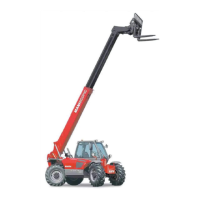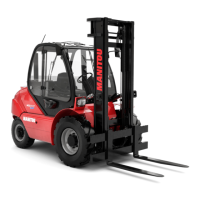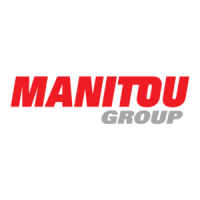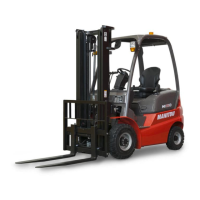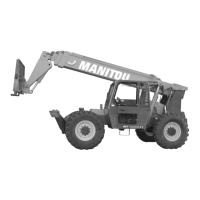VIVI
D.) SUSPENDED LOADSD.) SUSPENDED LOADS
A jib or truss boom should ONLA jib or truss boom should ONLY be used to lift and place loads when the machine is stationary and the frameY be used to lift and place loads when the machine is stationary and the frame
is level. is level. Transporting suspenTransporting suspended loads must ALded loads must ALWAWAYS be done slowly and cautiously, with the boom and loadYS be done slowly and cautiously, with the boom and load
as low as possible. Use as low as possible. Use taglines to restrict loads from swinging, to avoid overturn.taglines to restrict loads from swinging, to avoid overturn.
The handling of suspended loads by means of a truss boom or other similar device can introduce dynamicThe handling of suspended loads by means of a truss boom or other similar device can introduce dynamic
forces affecting the stability of the machine that are not considered in the stability criteria of industry testforces affecting the stability of the machine that are not considered in the stability criteria of industry test
standards. Grades and sudden starts, stops and turns can cause the load to swing standards. Grades and sudden starts, stops and turns can cause the load to swing and create a hazard.and create a hazard.
Guidelines for “Free Rigging / Suspended Loads”Guidelines for “Free Rigging / Suspended Loads”
1. 1. DO DO NOT NOT exceed exceed the the rated rated capacity capacity of of the the telescopic telescopic handler handler as as equipped equipped for for handling handling suspendedsuspended
loads. The weight of the rigging must be loads. The weight of the rigging must be included as part of the load.included as part of the load.
2.2. DurDuring ing tratranspnsportort, DO , DO NOT NOT rairaise tse the lhe load oad mormore the than 1an 12 in2 incheches (3s (305 m05 mm) am) abovbove the the gre grounound, od, or rar raiseise
the boom more than 45 degrees.the boom more than 45 degrees.
3.3. OnOnly ly lilift ft ththe e loload ad vevertrticicalally ly – – NENEVER VER drdrag ag it it hohoririzozontntalallyly..
4.4. Use Use mulmultiptiple pile pickuckup pop pointints on ts on the lohe load whad when pen possossiblible. Ue. Use tse taglaglineines to rs to restestrairain thn the loe load fad from rom swiswingingingng
and rotating.and rotating.
5.5. StStartart, tr, traveavel, tul, turn arn and snd stop top SLOSLOWLWLY to Y to preprevenvent tht the loe load fad from rom swiswinginging. ng. DO NODO NOT exT exceeceed wald walkinkingg
speed.speed.
6.6. InsInspecpect rit riggigging bng befoefore ure use. se. RigRigginging mug must bst be in e in googood cod condinditiotion ann and in d in the the U.S. U.S. comcomply ply witwith OSh OSHAHA
regulation §1910.184, “Slings,” or §1926.251, “Rigging regulation §1910.184, “Slings,” or §1926.251, “Rigging equipment for material handling.”equipment for material handling.”
7.7. RigRigginging eqg equipuipmenment attt attachached ted to tho the foe forks rks musmust be st be secuecured red sucsuch thh that iat it cant cannot not movmove eite either her sidsidewaeways orys or
fore and aft. The load center must not exceed 24 fore and aft. The load center must not exceed 24 inches (610 mm).inches (610 mm).
8.8. DO NODO NOT liT lift tft the lhe load oad witwith anh anyonyone on te on the lhe loadoad, ri, riggigging ong or lir lift eft equiquipmepment, nt, and and NEVENEVER lifR lift tht the loe load oad overver
personnel.personnel.
9. 9. Beware Beware of of the the wind, wind, which which can can cause cause suspended suspended loads loads to to swing, swing, even even with with taglines.taglines.
10.10. DO NDO NOT OT attattempempt tt to uo use fse framrame-le-leveevelinling tg to coo compempensansate fte for or loaload swd swinging..
U.S. OSHA regulations effective November 8, 2010 (29 CFR Part 1926, Subpart CC - U.S. OSHA regulations effective November 8, 2010 (29 CFR Part 1926, Subpart CC - Cranes and Derricks inCranes and Derricks in
Construction) include requirements for employers that use powered industrial trucks ("forklifts") configuredConstruction) include requirements for employers that use powered industrial trucks ("forklifts") configured
to hoist (by means to hoist (by means of a winch of a winch or hook) and or hook) and move suspended loads horizontallymove suspended loads horizontally. In par. In particularticular, this regulation, this regulation
applies to any rough-terrain forklift (e.g., "telescopic handler") equipped with a jib or truss boom with aapplies to any rough-terrain forklift (e.g., "telescopic handler") equipped with a jib or truss boom with a
hook (with or without a winch), or a hook assembly attached to the forks. [Note: This regulation is inhook (with or without a winch), or a hook assembly attached to the forks. [Note: This regulation is in
addition to the OSHA addition to the OSHA regulation that requires specific forklift regulation that requires specific forklift operator training: §1910.178(l).]operator training: §1910.178(l).]
When a forklift / telescopic handler is configured and used When a forklift / telescopic handler is configured and used for hoisting, the employer must ensure that:for hoisting, the employer must ensure that:
1. 1. Forklift, Forklift, lift lift equipment equipment and and rigging rigging have have been been inspected inspected (each (each shift, shift, month month and and year) year) and and are are inin
good, safe condition and properly installed.good, safe condition and properly installed.
2. 2. An An operator's operator's manual manual and and applicable applicable load load charts charts are are on on the the forklift.forklift.
3. 3. Work Work zone zone ground ground conditions conditions can can support support the the equipment equipment and and load. load. Any Any hazardous hazardous conditions conditions in in thethe
work area work area have been identified, and the operator notified.have been identified, and the operator notified.
4. 4. Equipment Equipment is is being being used used within within its its rated rated capacity capacity and and in in accordance accordance with with the the manufacturer'smanufacturer's
instructions.instructions.
WARNINGWARNING
